Electrolyte concentration - Study guides, Class notes & Summaries
Looking for the best study guides, study notes and summaries about Electrolyte concentration? On this page you'll find 5354 study documents about Electrolyte concentration.
Page 3 out of 5.354 results
Sort by
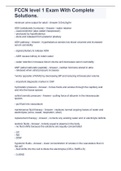
-
FCCN level 1 Exam With Complete Solutions.
- Exam (elaborations) • 13 pages • 2022
-
- $13.99
- 6x sold
- + learn more
minimum urine output for adult 0.5mL/kg/hr ADH (antidiuretic hormone) - water retainer - vasoconstrictor (also called Vasopressin) - produced by hypothalamus - store and released from posterior pituitary ADH pathway - hypothalamus senses low blood volumed and increased serum osmolality - signal pituitary to release ADH - ADH causes kidney to retain water - water retention increases blood volume and decreases serum osmolality ANP (atrial natriuretic peptide) -...
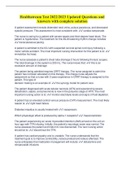
-
Healthstream Test 2022/2023 Updated Questions and Answers with complete solution
- Exam (elaborations) • 8 pages • 2023
-
Available in package deal
-
- $8.49
- 13x sold
- + learn more
Healthstream Test 2022/2023 Updated Questions and Answers with complete solution A patient assessment reveals distended neck veins, pulsus paradoxus, and decreased systolic pressure. This assessment is most consistent with: cardiac tamponade. The nurse is caring for a patient with severe sepsis and third-degree heart block. The patient is hypotensive. The treatment for this life-threatening rhythm change includes: transcutaneous pacing. A patient is admitted to the ICU with suspected ...

-
NURS 2106- Fluid and Electrolytes Questions with Complete Solutions
- Exam (elaborations) • 23 pages • 2024
-
- $16.49
- + learn more
Fluid and Electrolytes Correct Answer-necessary for life, homeostasis anticipate, identify, and respond to possible imbalances Correct Answer-nursing role for fluid and electrolyte balance 60 Correct Answer-approximately __% of typical adult is fluid (water and electrolytes) Osmosis Correct Answer-the diffusion of water caused by fluid and solute concentration gradients. - area of low concentration to area of high solute concentration. a higher concentration of extracellular sodiu...
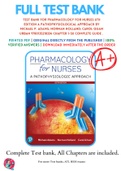
-
Test Bank For Pharmacology for Nurses 6th Edition A Pathophysiological Approach by Michael P. Adams; Norman Holland; Carol Quam Urban 9780135218334 Chapter 1-50 Complete Guide .
- Exam (elaborations) • 1458 pages • 2023
-
- $26.27
- 21x sold
- + learn more
Pharmacology for Nurses 6th Edition A Pathophysiological Approach by Michael P. Adams; Norman Holland; Carol Quam Urban 8334, 0 , 8438, 5 1 Introduction to Pharmacology 1.1 History of Pharmacology 1.2 Pharmacology: The Study of Medicines 1.3 Pharmacology and Therapeutics 1.4 Classification of Therapeutic Agents as Drugs, Biologics, Biosimilars, and Complementary and Alternative Medicine Therapies 1.5 Therapeutic and Pharmacologic Classification of Drugs 1.6 Chemical, Generi...
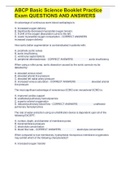
-
ABCP Basic Science Booklet Practice Exam QUESTIONS AND ANSWERS
- Exam (elaborations) • 5 pages • 2023
-
- $9.99
- 3x sold
- + learn more
ABCP Basic Science Booklet Practice Exam QUESTIONS AND ANSWERS An advantage of continuous warm blood cardioplegia is: A. Increased oxygen delivery B. Significantly decreased myocardial oxygen tension. C. A shift of the oxygen dissociation curve to the left. D. Lower myocardial oxygen consumption - CORRECT ANSWERS increased oxygen delivery Intra-aortic ballon augmentation is contraindicated in patients with: A. prosthetic aortic valves B. aortic insufficien...

-
Exam 1: NUR 3128 (Latest 2024- 2025 Update) Pathophysiology/ Pharmacology in Nursing 2| Review with Questions and Verified Answers- Grade A -100% Correct
- Exam (elaborations) • 20 pages • 2024
-
Available in package deal
-
- $10.99
- + learn more
Exam 1: NUR 3128 (Latest Update) Pathophysiology/ Pharmacology in Nursing 2| Review with Questions and Verified Answers- Grade A -100% Correct Q: Diabetes insipidus polyuria specific gravity Answer: urine specific gravity less than 1.005 (Normal 1.005 - 1.030) Q: Diabetes insipidus polyuria osmolality Answer: Urine osmolality less than 200 mOsm/kg (Normal 250-900 mOsm/kg) Q: Diabetes insipidus clinical findings Answer: Polyuria, Polydipsia, Nocturia, Thirst, t...

-
Exam 1: NUR2063/ NUR 2063 (Latest 2024/ 2025 Update) Pathophysiology | Review with Questions and Verified Answers| 100% Correct| Grade A- Rasmussen
- Exam (elaborations) • 33 pages • 2024
-
Available in package deal
-
- $11.99
- + learn more
Exam 1: NUR2063/ NUR 2063 (Latest 2024/ 2025 Update) Pathophysiology | Review with Questions and Verified Answers| 100% Correct| Grade A- Rasmussen Q: Which electrolyte will be deficient if patient presents with Tetany, the Chvostek's sign, or Trousseau's sign? (Stored in bones!) Answer: Calcium Q: What is Tetany? Answer: Involuntary contraction of muscles, symptoms include numb- ness around the mouth, muscle cramps, and paresthesias affecting the hands and feet, due to ...
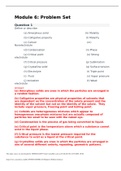
-
CHEM 103 Module 6 Problem Set 2023 Portage learning
- Exam (elaborations) • 6 pages • 2023
-
- $15.49
- 1x sold
- + learn more
Module 6: Problem Set Question 1 Define or describe: (a) Amorphous solid (k) Molality (b) Colligative property (l) Molarity (c) Colloid (m) Nonelectrolyte (d) Condensation (n) Phase (e) Critical point (o) Strong electrolyte (f) Critical pressure (p) Sublimation (g) Crystalline solid (q) Surface tension (h) Electrolyte (r) Triple point (i) Fluid (s) Vapor pressure (j) Ionization (t) Weak electrolyte Answer: (a) Amorphous solids are ones in which the particles are arrang...
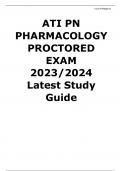
-
ATI PN PHARMACOLOGY PROCTORED EXAM 2023/2024 Latest Study Guide
- Exam (elaborations) • 137 pages • 2023
-
Available in package deal
-
- $18.99
- 42x sold
- + learn more
ATI PN PHARMACOLOGY PROCTORED EXAM A nurse is administering subcutaneous heparin to a client who is at risk for deep vein thrombosis. Which of the following actions should the nurse take? 1. Administer the medication into the client's abdomen. 2. Inject the medication into a muscle. 3. Massage the site after administering the medication. 4. Use a 22-gauge needle to administer the medication. A nurse is providing teaching to a client who has a urinary tract infection and new ...

-
WGU D236 Pathophysiology Questions And Answers 2023 (verified Q&A).
- Exam (elaborations) • 38 pages • 2023
-
Available in package deal
-
- $13.49
- 2x sold
- + learn more
WGU D236 Pathophysiology Questions And Answers 2023 (verified Q&A) What is Starling's Law of Capillary forces? How does this explain why a nutritionally deficient child would have edema? - Correct answer-Starling's Law describes how fluids move across the capillary membrane. There are two major opposing forces that act to balance each other, hydrostatic pressure (pushing water out of the capillaries) and osmotic pressure (including oncontic pressure, which pushes fluid into the cap...

How did he do that? By selling his study resources on Stuvia. Try it yourself! Discover all about earning on Stuvia


